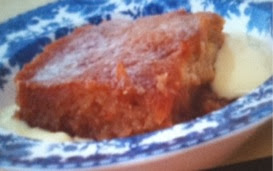Zoe Bauer

In honor of I Want Butterscotch Day, I decided to share a delicious butterscotch brownie recipe. But before you rush to your kitchen, you must first understand the difference between butterscotch and caramel, two confectionaries that often get confused despite their distinct flavors.
Caramel is made using white sugar and milk over low heat. And vanilla is often added to develop the caramel’s milky-ness. In contrast, butterscotch is made with brown sugar and butter or heavy cream. The brown sugar and butter give butterscotch a much warmer and richer appeal than caramel. While caramel is used in recipes to add a calm but sweet flavor, butterscotch is incorporated to make a dish warm and savory.
Now for the recipe!
Butterscotch brownie bars are at the top of the list when it comes to must-have butterscotch desserts. Each small butterscotch square gives off the perfect amount of sweetness to finish a meal. I love this recipe because it requires the creation of many different components.
First, prepare a typical chocolate brownie batter. I enjoy the method provided in this recipe for preparing the chocolate base of the brownie because it uses bittersweet chocolate chips, rather than already sweetened milk chocolate chips. The use of bittersweet chocolate allows the chef to sweeten the chocolate to his or her liking through the addition of buttery or sugary ingredients. This approach gives more depth to the chocolate layer of the butterscotch bars because each ingredient is added separately.

After spreading the brownie mixture along the bottom of your pan (make sure it’s greased or life will be hard later on!), it is time to swirl the butterscotch batter on top. Swirling is much easier than it looks. Simply drop spoonfuls of the butterscotch batter on top of the brownie layer. Then, holding a knife, make a circular motion with your hand to twirl the butterscotch into the chocolate. Try not to make too many spirals or you won’t be able to see the butterscotch once it is baked together.
Next, after baking them, amp up the brownie bars by spreading the chocolate ganache over the top. This mixture of butter, chocolate and heavy cream completes the brownie, topping it off with richness. The recipe also calls to sprinkle butterscotch chips over the chocolate ganache, which is a great way to balance out the chocolaty-ness of the dessert and to give previews of the butterscotch swirls to come!
Try the recipe out and let us know how you changed it up to work for you! Also, what drink goes best with this rich treat? ... Milk? Tea? Leave a comment!





